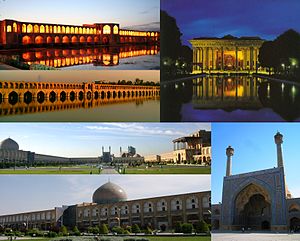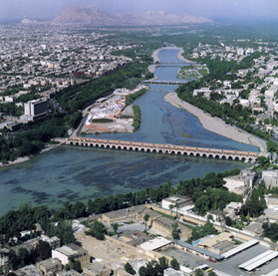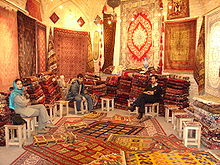Isfahan historically also rendered in English as Ispahan, Sepahan, Esfahan or Hispahan, is the capital of Isfahan Province in Iran, located about 340 kilometres (211 miles) south of Tehran. It has a population of 1,583,609 and is Iran's third largest city after Tehran and Mashhad. The Greater Isfahan Region had a population of 3,793,101 in the 2011 Census, the second most populous metropolitan area in Iran after Tehran.

The cities of Zarrinshahr, Fooladshahr and Najafabad, Se-deh, Shahin-shahr, Mobarakeh, Falavarjan and Charmahin all constitute the metropolitan city of Isfahan.
Isfahan is located on the main north-south and east-west routes crossing Iran, and was once one of the largest cities in the world. It flourished from 1050 to 1722, particularly in the 16th century under the Safavid dynasty, when it became the capital of Persia for the second time in its history. Even today, the city retains much of its past glory. It is famous for its Islamic architecture, with many beautiful boulevards, covered bridges, palaces, mosques, and minarets. This led to the Persian proverb "Esfahān nesf-e jahān ast" (Isfahan is half of the world). Today Isfahan, the third largest city in Iran, produces fine carpets, textiles, steel, and handicrafts
Transportation
Airport
Isfahan is served by the Isfahan International Airport which handles domestic flights to Iranian cities and international flights, mostly to regional destinations across Middle East and central Asia including Dubai and Damascus.
How to reach Isfahan
Turkish Airlines is the only International Airline serving to Isfahan with 4 weekly flights. You can reach Isfahan via Istanbul at 23:00 (TK892) on Tuesday, Wednesday, Saturday and Sunday; and return back at 03:35 (TK893) on Wednesday, Thursday, Sunday and Monday.
Metro and Inter City Public Transportation[edit]Isfahan Metro is under construction and will include 2 lines with 43 km (27 mi) length. The first line of that is planned to be finished by end of 2010 with 21 km (13 mi) length and 20 stations.Until the metro is completed an expanded bus system accompanied by taxis will handle Isfahan intra-urban public transportation.
Road transport
Isfahan's internal highway network is currently under heavy expansion which began during the last decade. Its lengthy construction is due to concerns of possible destruction of valuable historical buildings. Outside the city, Isfahan is connected by modern highways to Tehran which spans a distance of nearly 400 km (248.55 mi) to North and to Shiraz at about 200 km (124.27 mi) to the south. The highways also service satellite cities surrounding the metropolitan area.

Culture
An old master of hand-printed carpets in Isfahan bazaarRug manufacture Main article: Isfahan rug Isfahan has long been one of the centers for production of the famous Persian Rug. Weaving in Isfahan flourished in the Safavid era. But when the Afghans invaded Iran, ending the Safavid dynasty, the craft also became stagnant.


The cities of Zarrinshahr, Fooladshahr and Najafabad, Se-deh, Shahin-shahr, Mobarakeh, Falavarjan and Charmahin all constitute the metropolitan city of Isfahan.
Isfahan is located on the main north-south and east-west routes crossing Iran, and was once one of the largest cities in the world. It flourished from 1050 to 1722, particularly in the 16th century under the Safavid dynasty, when it became the capital of Persia for the second time in its history. Even today, the city retains much of its past glory. It is famous for its Islamic architecture, with many beautiful boulevards, covered bridges, palaces, mosques, and minarets. This led to the Persian proverb "Esfahān nesf-e jahān ast" (Isfahan is half of the world). Today Isfahan, the third largest city in Iran, produces fine carpets, textiles, steel, and handicrafts
Transportation
Airport
Isfahan is served by the Isfahan International Airport which handles domestic flights to Iranian cities and international flights, mostly to regional destinations across Middle East and central Asia including Dubai and Damascus.
How to reach Isfahan
Turkish Airlines is the only International Airline serving to Isfahan with 4 weekly flights. You can reach Isfahan via Istanbul at 23:00 (TK892) on Tuesday, Wednesday, Saturday and Sunday; and return back at 03:35 (TK893) on Wednesday, Thursday, Sunday and Monday.
Metro and Inter City Public Transportation[edit]Isfahan Metro is under construction and will include 2 lines with 43 km (27 mi) length. The first line of that is planned to be finished by end of 2010 with 21 km (13 mi) length and 20 stations.Until the metro is completed an expanded bus system accompanied by taxis will handle Isfahan intra-urban public transportation.
Road transport
Isfahan's internal highway network is currently under heavy expansion which began during the last decade. Its lengthy construction is due to concerns of possible destruction of valuable historical buildings. Outside the city, Isfahan is connected by modern highways to Tehran which spans a distance of nearly 400 km (248.55 mi) to North and to Shiraz at about 200 km (124.27 mi) to the south. The highways also service satellite cities surrounding the metropolitan area.

Culture
An old master of hand-printed carpets in Isfahan bazaarRug manufacture Main article: Isfahan rug Isfahan has long been one of the centers for production of the famous Persian Rug. Weaving in Isfahan flourished in the Safavid era. But when the Afghans invaded Iran, ending the Safavid dynasty, the craft also became stagnant.
